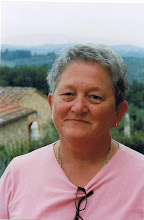MUSIC IN MILAN
DAY 4
ANSALDO
Quite early in the morning on Thursday we had a reservation at Ansaldo, the production facility of La Scala. We took a bus to its location, somewhat far from the Hotel de la Ville, but still in the city of Milan. Ansaldo is located in a former steel factory. Because it produces the sets and costumes for La Scala's future performances, photography of this proprietary material is not allowed.
We entered into a narrow hallway to see a model of La Scala. It consists of not only the old building which you see here, but also a white boxy addition to the right back, which you can see the top of in this photo. To the left back, is a round addition.
The box was recently added and holds a much enlarged stage, a fancy, high tech mechanism for quickly switching sets, and set storage space. Sets are mostly made of foam core these days. There is some wooden structures, but the wall facades are polystyrene and canvas. The round addition holds offices.
Next we walked onto the first of many catwalks to view canvas painting in progress. Canvas is spread on the floor in a football-sized space. When we were there, there were 2 canvasses filling this space. Everything is done by hand - no autoCAD designs are superimposed to do the set design quickly. First the canvas is prepared to accept the charcoal designs and later paint. I suppose this is like Gesso. I guess the set designer sketches the design which is then proportioned to fill the canvas. It is then drawn onto the canvas using a large compass and straightedges. After the design is drawn, it is slowly painted by a troupe of people who hold bamboo sticks with paintbrushes attached to the ends. Very carefully, these painters tread upon the canvas and gently paint the designs.
We saw both the Gesso-ing process and the painting. The Gesso is applied by spray cans, not brushes. It really stinks in there, despite an air filtration system. There was a huge "No Smoking" sign.
All along the catwalk above the canvasses, there were models of the sets of various operas, sometimes several from the same opera performed during different decades, depicting different fashions, styles, and technical advances.
We next went into the prop room, where the people were building landscapes out of greenery and sculpting large figures. It's really a pity I have no photos, because I can't remember everything that was there. What was striking was that these were all (150+ total) artists and artisans working at their craft. You could feel that energy.
There are overhead cranes and conveyor belts left over from the steel mill days and which are now used to carry the heavier parts of the set design to the assembly room. We passed through the carpenters' hall where smaller parts were being produced. What we noticed there was that no one was wearing protective gear. OSHA would have a fit.
Then we came to the final set room, where the set is assembled and completed. This particular day the set was probably 3 stories high and must have been at least 3000 square feet. It filled about one-third of the room. We were in a huge facility! I don't know what opera this set was for. Someone else might remember .... or we might not have been told: proprietary knowledge.
Off to the costumes. In the hallway was a rack of sample costumes from which we saw the minute detail even a sample has. Samples are made to determine the proper effect of the singer's movement, to ensure that a singer doesn't fold under the weight of an armored suit, for example, or to make sure that hats stay put during an excited aria.
We only saw a small part of the storage room for these. Here in glass cases were dresses worn by Maria Callas (I forget which ones, but maybe someone will remember...) and others. Approximately 1000 costumes are made each season; others are refashioned from the huge wardrobe room.
We were not allowed to view the actual sewing room, partially because the seamstresses need to focus and can't be interrupted, but also because many of the cast come in for fittings and do not like to be caught in compromised situations! It's unbefitting. I would have liked to see shoes being made, but alas, shoes are contracted out someplace, so that wish was never fulfilled.
So our tour of Ansaldo gave us all a deeper appreciation of the work that goes into an opera; it is indeed a piece of work for many.


No comments:
Post a Comment